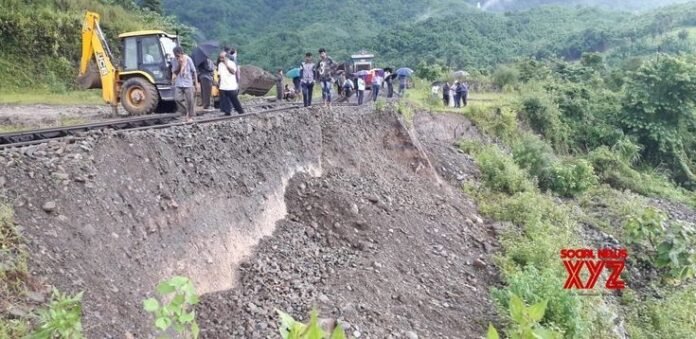In a major setback to transportation in Northeast India, railway track damage near New Haflong has led to widespread disruption of train services. The damage, caused by slope failure during National Highways Authority of India (NHAI) construction, has left rail infrastructure buried under mud, rocks, and water runoff.
This incident highlights the dangers of unregulated slope excavation in sensitive terrain and raises questions about coordination between highway and railway authorities.
What Caused the Railway Track Damage ?
The railway track damage was triggered by ongoing NHAI road-widening work, which destabilized the hillside above the New Haflong–Ditokcherra railway section. Heavy rains accelerated the slope failure, causing a massive debris slide onto the tracks.
“We observed uncontrolled water flow and debris from highway construction above the track alignment,” said an NFR official.
The affected railway section is a lifeline linking Assam to Tripura, Mizoram, and Manipur via Silchar.
The monsoon rains that lashed the region over the weekend further loosened the soil, making the slope more prone to collapse. This combination of human activity and natural factors culminated in one of the worst railway disruptions in recent years.
Train Services Suspended Due to Railway Track Damage
As a direct result of the railway track damage, the Northeast Frontier Railway (NFR) has suspended services on this critical corridor. This includes:
- Goods trains carrying fuel and essentials
- Passenger services including the Kanchanjunga Express
- Medical and emergency rail support
With monsoon rains ongoing, there’s no clear estimate yet for full service restoration.
Safety Concerns Escalate After New Haflong Slope Failure
The slope collapse that led to railway track damage near New Haflong has amplified concerns about unsafe construction practices. Environmental experts argue that NHAI’s lack of proper drainage and retaining systems during their project directly contributed to the slope’s failure.
“This isn’t just bad planning—it’s a failure of inter-departmental communication and oversight,” said a Northeast-based civil engineer.
Similar incidents have occurred across Arunachal Pradesh and Sikkim, where infrastructure expansion outpaces geological risk assessment.
Ongoing Repairs After Railway Track Damage
Restoration work is underway following the railway track damage but progress is slow due to unstable weather and terrain. The NFR has deployed:
- Excavators and geotechnical teams
- Emergency slope stabilization crews
- Reinforcement specialists from Silchar and Lumding divisions
“We’re monitoring slope stability before deploying heavy machinery,” NFR engineers confirmed.
More on Indian Railways emergency response measures
Environmental Impact of Railway Track Damage
The New Haflong region is part of an ecologically fragile zone. The railway track damage caused by slope failure has also:
- Blocked natural water drainage
- Disrupted local flora and fauna
- Increased erosion risk downstream
This underscores the need for eco-sensitive infrastructure planning in the Northeast.
Explore Ministry of Environment’s policy on hill infrastructure
Who Bears Responsibility?
While weather played a role, experts and activists say the core issue is infrastructural negligence.
The National Highways Authority of India, in its bid to fast-track highway development, allegedly proceeded with steep slope cutting without adequate safety reinforcements.
Railway Track Damage Near New Haflong Demands Urgent Reform
The railway track damage near New Haflong is a warning signal. While development is essential, it must not come at the cost of safety and environmental balance. A coordinated approach between NHAI, NFR, and environmental bodies is crucial to prevent future disasters in this vulnerable region.
READ MORE: Nagaland Tribal Dialects Must Be Recognized, Says MP




